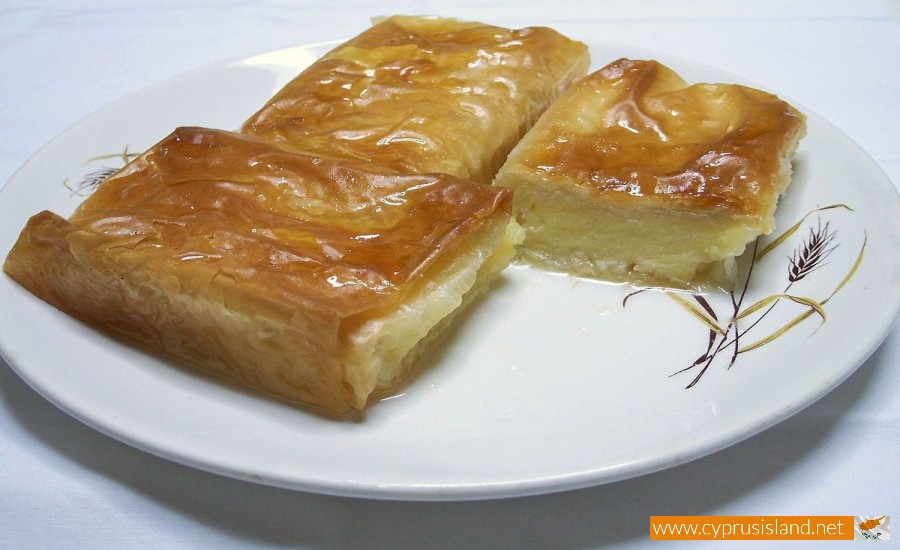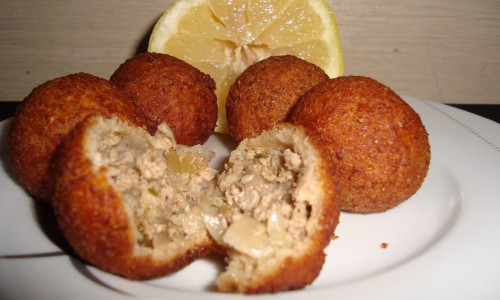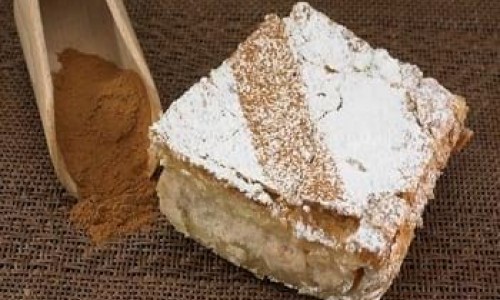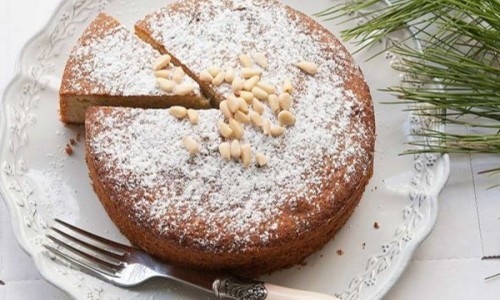Galaktoboureko
Golden, syrupy, and irresistibly creamy, galaktoboureko is the kind of dessert that commands attention. A luscious custard encased in crisp layers of buttery phyllo pastry and soaked in fragrant syrup, galaktoboureko has long held a place of honor on Greek and Cypriot dessert tables—from Sunday family feasts to weddings, name days, and festive holidays.
Its name may be a mouthful, but once you've had a taste, it's one you'll never forget.
What is Galaktoboureko?
At its heart, galaktoboureko (γαλακτομπούρεκο) is a semolina-based custard pie wrapped in layers of phyllo, baked to golden perfection, and soaked in a sweet, citrus-scented syrup. The name is a combination of:
- “Gala” (γάλα) – Greek for milk
- “Boureki” (μπουρέκι) – a Turkish word for a filled pastry
The result is a dessert that beautifully bridges Greek and Ottoman culinary influences—flaky and syrupy like a baklava, but soft and creamy like a milk pudding.
A Tale of Two Textures
One of galaktoboureko’s most striking features is the contrast in textures:
- The top and bottom layers of phyllo are buttery and crisp, giving a delicate crunch with every bite.
- The custard filling is smooth, rich, and gently firm—set enough to slice but soft on the tongue.
- The final syrup soak transforms the dish into a gooey, melt-in-your-mouth experience without making it soggy.
When made right, every bite balances sweetness, structure, and silkiness
Ingredients and Preparation
Despite its elegance, galaktoboureko is made from humble ingredients:
For the Custard (Cream):
- Full-fat milk
- Fine semolina (not flour!)
- Sugar
- Eggs (often just yolks for richness)
- Butter
- Vanilla, lemon zest, or even mastiha for flavor
For the Phyllo Layers:
- Commercial or homemade phyllo pastry sheets
- Melted unsalted butter
For the Syrup:
- Sugar
- Water
- A strip of lemon or orange peel
- Sometimes a splash of honey or a cinnamon stick
How It's Made:
- The Custard is cooked gently on the stove—semolina is added to warm milk, thickened slowly, then enriched with eggs and flavorings.
- The Phyllo Layers are buttered one by one in a baking tray, forming a base.
- The custard is poured in, then topped with more phyllo, carefully buttered to achieve that golden crisp.
- The pie is scored into portions before baking to make syrup absorption easier.
- It’s baked until golden, then immediately soaked in cold syrup (or vice versa—cold galaktoboureko with hot syrup).
Galaktoboureko in Cyprus
While galaktoboureko is enjoyed throughout the Hellenic world, Cypriot versions tend to be:
- Slightly less sweet than mainland styles
- More likely to be flavored with citrus zest (especially orange)
- Often seen during Easter and celebratory occasions
- Served in both squares (tray-baked) or in individual rolls (spiral-shaped or cigar-style)
In Cyprus, many village bakers still make galaktoboureko using fresh sheep or goat milk, giving the custard an extra layer of richness.
Variations Across Greece and Beyond
While the core recipe remains relatively stable, there are a few regional and modern takes:
- Individual Rolls: Instead of a tray, the custard is rolled into single-serving phyllo cigars before baking.
- With Mastiha or Rose Water: Some versions add these fragrant ingredients to the custard or syrup.
- Chocolate Galaktoboureko: A modern twist where cocoa or chocolate is folded into the custard.
- Galaktoboureko Cheesecake: A fusion dessert seen in upscale patisseries.
That said, the traditional version remains the gold standard.
Galaktoboureko vs. Similar Desserts
People often confuse galaktoboureko with bougatsa, but they’re quite different:
- Bougatsa: Often filled with custard too, but typically dusted with powdered sugar and cinnamon, and served without syrup.
- Baklava: Syrupy like galaktoboureko, but made with nuts and honey, not custard.
- Revani or Halvas: Also semolina-based, but denser and cake-like.
Galaktoboureko occupies a category of its own: milk-based, baked, and syrup-soaked.
When and How to Serve Galaktoboureko
Galaktoboureko is most often served as a dessert after festive meals, particularly on:
- Sunday family gatherings
- Name days
- Weddings
- Easter celebrations
- Café and taverna menus, especially in rural areas
It is usually served at room temperature or cold, allowing the syrup and custard to set perfectly. Some prefer it slightly warm, especially when freshly made.
Pair it with:
- A cup of strong Greek coffee
- A glass of cold water
- Or even a small shot of ouzo or zivania for a bold contrast
Tips for Perfect Galaktoboureko
- Use fine semolina for a smooth custard texture.
- Don't overcook the custard—it will thicken more as it bakes.
- Score the phyllo before baking to prevent it from cracking.
- Always add cold syrup to hot pie (or hot syrup to cold pie)—this prevents sogginess and ensures proper absorption.
- Use good-quality butter, ideally Greek or Cypriot, for an authentic flavor.
A Dessert That Brings People Together
Galaktoboureko is more than just a sweet treat—it's a celebration of home, heritage, and hospitality. It's a dessert that’s both luxurious and familiar, indulgent yet comforting. The act of layering phyllo, stirring custard, and watching it all bake to golden perfection is one that connects generations in Greek and Cypriot households.
To eat galaktoboureko is to experience a culinary hug—rich, golden, sticky, and warm. And when done right, it’s nearly impossible to stop at one piece.









